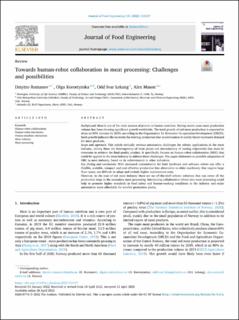| dc.contributor.author | Romanov, Dmytro | |
| dc.contributor.author | Korostynska, Olga | |
| dc.contributor.author | Lekang, Odd Ivar | |
| dc.contributor.author | Mason, Alex | |
| dc.date.accessioned | 2023-03-07T12:46:25Z | |
| dc.date.available | 2023-03-07T12:46:25Z | |
| dc.date.created | 2022-05-08T16:03:02Z | |
| dc.date.issued | 2022 | |
| dc.identifier.citation | Journal of Food Engineering. 2022, 331 . | |
| dc.identifier.issn | 0260-8774 | |
| dc.identifier.uri | https://hdl.handle.net/11250/3056461 | |
| dc.description.abstract | Background Meat is one of the main sources of protein in human nutrition. During recent years meat production volume has been showing significant growth worldwide. The total growth of red meat production is expected to show an 80% increase by 2029, according to the Organisation for Economic Co-operation Development (OECD). Such growth indicates the necessity for existing production line modernisation to satisfy future increased demand for meat products. Scope and approach This article critically reviews automation challenges for robotic applications in the meat industry, among those are heterogeneity of meat pieces and inconsistency of cutting trajectories that must be overcome to achieve the final quality product. It specifically focuses on human-robot collaboration (HRC) that could be applied in the meat industry to address these challenges. The paper elaborates on possible adaptation of HRC in meat industry, based on its achievements in other industries. Key finding and conclusions With increased customisation for both hardware and software robots can offer a flexible, scalable, compact and cost-effective production line alternative to older machinery that require large floor space, are difficult to adapt and include higher maintenance costs. However, in the case of red meat industry there are no off-the-shelf robotic solutions that can cover all the production steps in the secondary meat processing. Introducing collaborative robots into meat processing could help to promote higher standards in food safety and human-working conditions in the industry and make automation more affordable for smaller production plants. | |
| dc.description.abstract | Towards human-robot collaboration in meat processing: Challenges and possibilities | |
| dc.language.iso | eng | |
| dc.relation.uri | https://www.sciencedirect.com/science/article/pii/S0260877422001716#ack0010 | |
| dc.title | Towards human-robot collaboration in meat processing: Challenges and possibilities | |
| dc.title.alternative | Towards human-robot collaboration in meat processing: Challenges and possibilities | |
| dc.type | Peer reviewed | |
| dc.type | Journal article | |
| dc.description.version | publishedVersion | |
| dc.source.pagenumber | 14 | |
| dc.source.volume | 331 | |
| dc.source.journal | Journal of Food Engineering | |
| dc.identifier.doi | 10.1016/j.jfoodeng.2022.111117 | |
| dc.identifier.cristin | 2022485 | |
| dc.relation.project | EU/871631 | |
| cristin.ispublished | true | |
| cristin.fulltext | original | |
| cristin.qualitycode | 1 | |
